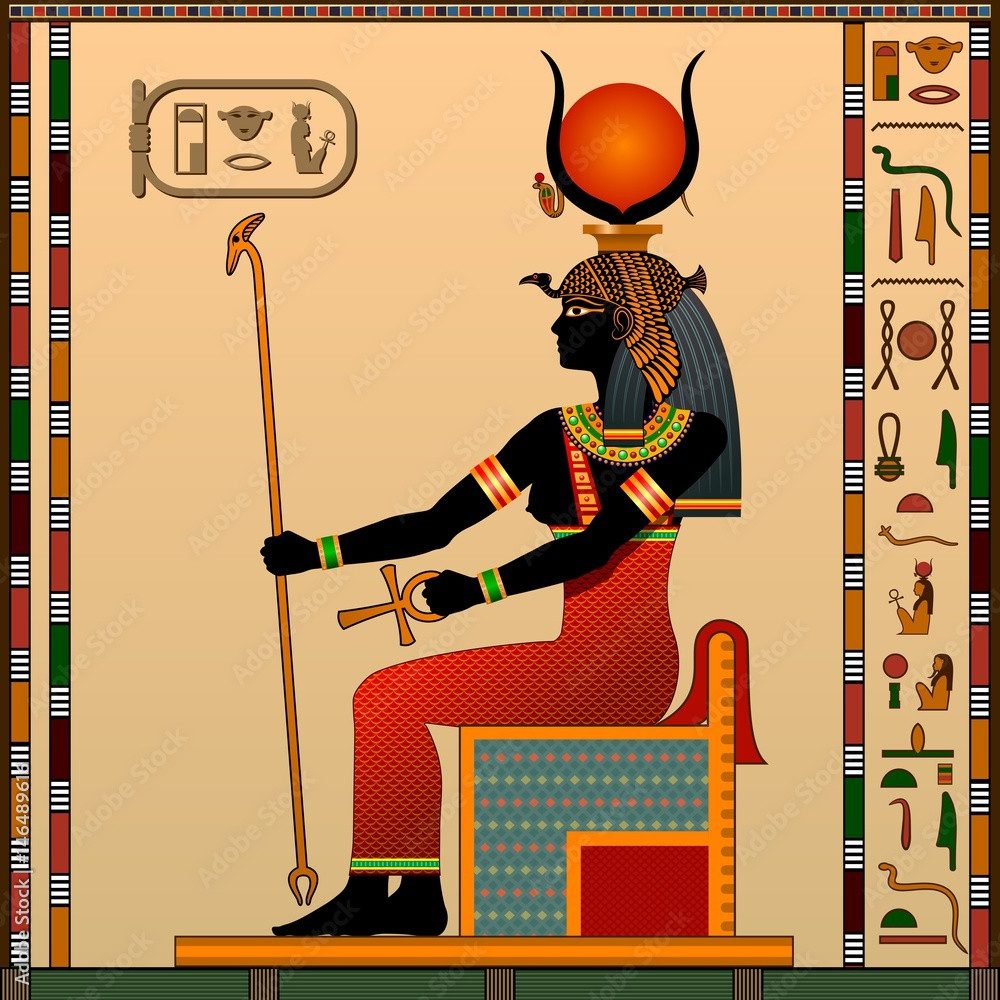Hathor: The Multifaceted Goddess of Love, Joy, and Music
Introduction: A Goddess You Can Feel Close To
Imagine stepping into an ancient Egyptian temple. The air is filled with the scent of incense, and gentle music sounds in the distance. On the walls, you see the image of a beautiful woman with cow ears and a sun disk between her horns. This is Hathor, one of the most beloved and multifaceted goddesses of ancient Egypt.
Who is Hathor?
Hathor is not just one goddess – she is many goddesses in one. Her roles are as varied as life itself:
-
Goddess of Love and Beauty
-
Protector of Women and Children
-
Patroness of Music and Dance
-
Mistress of the Sky
-
Goddess of Joy and Ecstasy
The Many Faces of Hathor
The Loving Mother Goddess
Hathor was often depicted as a cow nursing the young pharaoh, symbolizing gentle, nurturing care and protection.
The Seductive Goddess of Beauty
In her role as goddess of love and beauty, Hathor appeared as a stunning woman. She was the patroness of cosmetics and jewelry – important to both men and women in ancient Egypt.
The Heavenly Musician
With her sistrum, a kind of sacred rattle, Hathor brought music and dance into the world. Raucous festivals were held in her honor.
Symbols and Depictions
-
Cow: Symbol of motherhood and nourishment
-
Beautiful Woman with Cow Ears: Connection between human and divine beauty
-
Lioness: Her fierce and dangerous aspect
-
Hathor Head: Often found as column capitals in temples
-
Sistrum: Her sacred musical instrument
-
Menit Necklace: Symbol of joy and sensual pleasure
Myths and Legends
The Story of the Eye of the Sun
One famous legend tells how Hathor, as the “Eye of Ra,” was sent to punish rebellious humanity. In her rage, she transformed into the fierce lioness goddess Sekhmet and threatened to destroy all humankind. Only a clever trick – dyeing beer red so she thought it was blood – could calm her down. This tale reveals Hathor’s dual nature: loving and terrible, just like nature itself.
Hathor in Daily Life of the Ancient Egyptians
Hathor was not a distant deity. She was deeply woven into everyday life.
-
Love and Relationships: Lovers called upon Hathor’s blessing to fill their hearts with love.
-
Beauty and Self-Care: Cosmetics and mirrors were often decorated with Hathor symbols, honoring her through personal grooming.
-
Music and Festivities: Festivals in Hathor’s name were famous for their joyful music, dance, and (plentiful) beer.
-
Birth and Motherhood: Pregnant women prayed to Hathor for protection for themselves and their babies.
Hathor Temples: Places of Worship
Some of Egypt’s most beautiful temples were dedicated to Hathor, especially the famous Temple of Dendera:
-
Built over centuries, completed during Roman times
-
Renowned for stunning reliefs and well-preserved colors
-
Features the “Celestial Ceiling of Dendera,” a fascinating astronomical depiction
Pilgrims from all over Egypt would come here to honor Hathor and seek her favor.
Hathor in Art
Hathor’s depictions are among the most beautiful in ancient Egyptian art:
-
Graceful statues of the cow-headed goddess
-
Finely crafted sistrums decorated with Hathor motifs
-
Splendid wall paintings in temples and tombs
-
Delicate jewelry bearing Hathor symbols
Hathor and Other Gods
Hathor was closely linked to many other Egyptian deities:
-
Ra: As “Eye of Ra” and “Daughter of Ra,” she was closely connected to the sun god
-
Horus: In some traditions, considered his consort
-
Isis: Both shared similar roles and were sometimes merged in worship
Hathor Today: A Timeless Symbol
Though active worship of Hathor ended long ago, her spirit lives on in many ways:
-
Archaeology: Discoveries and restorations of Hathor temples fascinate scholars and visitors alike
-
Spirituality: Some modern spiritual movements invoke Hathor as a symbol of divine femininity
-
Art and Culture: Hathor motifs continue to inspire artists and designers
-
Popular Culture: Hathor appears as a fascinating figure in books, films, and games
Conclusion: Hathor’s Timeless Message
Hathor may be a goddess from a long-past era, but her message is timeless. She reminds us to:
-
Celebrate the beauty of life
-
Welcome love and joy into our lives
-
Harness the power of music and dance
-
Recognize our own inner divinity
In a world often filled with stress and rush, Hathor inspires us to pause and enjoy life’s beautiful moments. Whether through self-care, music, or celebration with friends, you can feel Hathor’s spirit.
Next time you see an image or statue of Hathor, remember: you are looking not just at an ancient goddess but at a symbol of life’s eternal joys. Let her smile remind you to embrace and celebrate life in all its facets.
So go ahead: invite a little Hathor spirit into your life — celebrate love, enjoy beauty, and dance like no one is watching!

